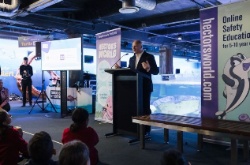Bright Sparks HiTech Competition 2002
Bright Sparks HiTech Competition 2002
The Bright Sparks Hi-tech Competition encourages young New Zealand students to design and build electronic and software projects. The Competition is part of the ETITO’s broader Bright Sparks programme, which aims to capture the brightest young people for New Zealand’s hi- tech industries.
111 projects were entered this year, compared to 89 in 2001, 35 in 2000, 25 in 1999 and 7 in 1998 (the first year of the Competition). An independent panel of industry judges carried out judging.
It has been observed that the quality of the best projects entered by the students in the Competition this year is of a very high standard.
Dick Smith Electronics, as the major sponsor of this Competition, has made possible the institution of four new awards: a junior and senior ‘Most Innovative use of a DSE Kitset’ awards and overall Junior and Senior Supreme Awards. These four new awards are made possible through the sponsorship of Dick Smith Electronics.
Gough Technology has again provided quality multimeters from Fluke for first placegetters in each of the eight sections.
Bright Sparks acknowledges the generous support of its sponsors: Dick Smith Electronics (promotion of the Competition, prizes, travel fund for students to attend the Awards), Gough Technology (prizes), Microsoft (prize).
ETITO also applauds and thanks all mentors, teachers and family members who have supported the students who entered this year’s Competition.
Ross Petersen Bright Sparks Manager Competition Results CATEGORY A: MODIFY A KITSET (11-14 YRS) Entrants presented modifications to a purchased kitset. (either to the electronic circuit or its application in a useful product).
1st Daniel Sanson 14 yrs Taradale High School, Hawkes Bay Pool filter robot bug: Daniel got the idea to make this robot when he noticed the amount of dirt accumulating on the bottom of the family swimming pool. Built around a DSE Universal Timer kit, this clever helper ‘bug’ skitters around the floor of the pool, propelled by the jet of water being sucked through the intake and out the back. When a sensor detects the bug has reached the end wall of the pool, the thrust moves to a side pipe and so off it goes again in a new direction.
2nd Gerard Moat/ Matthew Kershaw 13 years Havelock North Intermediate Short wave radio: Gerard and Matthew were interested in making a radio, but set their sights beyond the horizon with their short-wave receiver. Three DSE kitsets: the IC SW receiver, the Simple Amplifier and the LED Level Display were spliced together to make this ambitious project.
3rd Charlotte Munro 11 years Murrays Bay Intermediate School, Auckland Ultrasonic mosquito repeller: Did you know that only female mosquitos bite? And only when they are beefing up to lay eggs? Charlotte has found that at this time the high-pitched whine of the male irritates the female so much she high-tails it. To save you carrying a male mosquito in your pocket, Charlotte has taken a DSE kitset and packaged it into a handy personal mosquito repeller. No more smelly sprays!
Highly Commended: Liang Chen 12 yrs Devon Intermediate School, New Plymouth Keyed desk alarm: Liang combined a DSE Light Activated Switch and a Siren kitset together with a keyed barrel switch to create this attractive and functional alarm, all housed professionally with its battery and an on-off switch in a PVC slot box. Liang says this has solved a problem with classmates ‘borrowing’ stuff out of his desk.
Liang also wins the Junior Dick Smith Kitset Award (Most innovative use of a Dick Smith Kitset)
Highly Commended: Caitlin McMurtrie 12 yrs Tauranga Intermediate School Parent Alarm: Caitlin’s has also utilised DSE kits to produce an alarm which sounds when the headlights of the family car shine in the window on its return home.
CATEGORY A: MODIFY A KITSET 15-18 YRS)
No award was made in this category for 2002.
CATEGORY B: MODIFY A PUBLISHED CIRCUIT. ( 11-14YRS) ( 15-18YRS) Entrants modified either the circuit itself or made adaptations or changes to develop a useful end product. Junior
1st Isuru Pathirana 11 yrs Remuera Intermediate School, Auckland Floor cleaning robot. Isuru’s house-conscious robot moves around the floor picking up lint and dirt on a electrostatic pad mounted underneath its body. Isuru soldered this complex circuit together on veroboard. Two independently controlled motors power the drive to the wheels through gearboxes. A front bumper bar activates a micro switch to put the robot into reverse when it strikes an obstacle.
2nd Peter Leijen 13 yrs Havelock North Intermediate School, Hawkes Bay Electronic keyboard: Peter has put two modified DSE kitsets (Dog and Cat Communicator and the Simple Amplifier) together to make this portable amplified piano. He has even included a shoulder strap in the package. Peter has added a microphone input for the karaoke option.
3rd Tushar Sharma 11 yrs Devon Intermediate School, New Plymouth Dusk monitor: Ever gone away on holiday wondering whether the burglars are watching your house? Well, Tushar has come up with a solution. His Dusk Monitor is a modification of the DSE Light Activated Switch circuit. It turns on the house lights when it gets dark, so people think someone is home. Tushar has even mounted his device inside a model house. Tushar adds in his credits: ‘Thanks Mum, for buying the things I needed and holding the wire when I was soldering.’
Highly Commended: Thomas O’Flaherty/ Josheel Pranal, St Peter’s College, Auckland. Magnetic Levitator: These guys have attempted the seemingly impossible with their electronically controlled magnet, designed to hold a steel ball bearing motionless in mid-air! The circuit uses an infra-red emitter that sends a beam across to two IR receiver transistors, one a signal detector and the other a reference detector. If the steel ball is below the beam, the circuit energises the electromagnet to lift the ball higher. When the ball rises enough to start to block the beam, power is reduced to the magnet, so the ball falls again. The circuitry incorporates an op-amp comparator, inverter and amplifier.
Highly Commended: Melissa Stephen, Kamo Intermediate School, Whangarei Childs learning game: I saw a two-year-old yesterday playing with this wonderful little coordination game, totally engrossed. If you can link the questions to the correct parts of Teddy’s body, a light comes on e.g. ‘Where is Teddy’s ear?’ What a great concept, with the market potential being properly researched by Melissa.
Highly Commended: Lance Wills, Tauranga Intermediate School Rain detector: A ‘rain catcher’, with a pair of contacts that are bridged when the water falls on them. The water catcher sits on the roof, with the electronics and a warning buzzer below in the house.
Senior
1st Robert Wilson, Robert Coleman, Richard Fairhall 17 yrs Christ’s College, Christchurch Electronic access system: This sophisticated project employs a PIC18F84 micro programmed in PIC Basic to read a personalised pronged ‘key’ when it is inserted in a socket, activates a solenoid (to open the door) and displays a personalised message on a 2-line LCD screen. If you do not have the correct key, access is denied. The entrants overcame considerable problems to finally achieve a working prototype.
2nd Alan Grimmer 15 yrs Papatoetoe High School, Auckland Beam robotic ant: Alan is right into BEAM (Biology, Electronics, Aesthetics, Mechanics) technology. His light-seeking robot won its section in this competition last year. Alan’s Beam Ant Bug is (in his words) ‘a little critter that gets around on two motors’. He has moved through a number of prototypes, solved H-bridge problems (this controls the motors), PCB layout and mechanical issues. The heart of the petite blue robo-ant is a 74AC240 chip which includes the H-bridge and the switching transistors to charge and discharge the energy-storing capacitors that ‘pop’ each motor along.
3rd Tom Waymouth 15 yrs Kamo High School, Whangarei Backup lighting: What happens when the power goes off and you’re left in the dark? Tom paints a scenario where his Granny is sitting in her chair. Suddenly, the power fails and she is plunged into rural Northland darkness. Stumbling through the house, she trips and breaks her leg. Tom has designed a circuit, based on one he found on the internet, designed to prevent this scenario. It is a UPS (uninterrupted power supply) that models the sort of back-up system that is used in places where continued power supply is critical.
Highly Commended: Christina Lin, Macleans College, Auckland Rainbow Robot: Christina’s robot makes a real impression as it shuffles across the tabletop in search of light. Its rainbow coloured wings and legs conceal the functionality of the circuit board beneath. A capacitor charge-discharge cycle pulses the twin motors alternately. Their shafts grip the table and so the butterfly moves forward.
CATEGORY C ORIGINAL CIRCUIT DESIGN ( 11-14YRS) ( 15-18 YRS) Entrants in this category designed a circuit, or a modification of an existing circuit, to produce a useful finished product. Junior
1st David Hursthouse 12 yrs Murrays Bay Intermediate School, Auckland Wakeup call: Ever found it hard to get up in the morning ? Is waking up a shock to the system? David has designed a gentler introduction to the day with his light-activated Wake-up Call. Light-activated circuits spring into action, relays click, motors whirr and draw the curtains while the bedroom lights go up and soft music plays. What a great introduction to a new day for a non-morning person !
2nd Ryan Agate 13 yrs Remuera Intermediate School, Auckland Scare-D-Cat: Cats a problem? Scare-D-Cat is the perfect present for the dog-lover set. Ryan’s device detects tree-scratching cats with a PIR sensor, turns on a searchlight and activates a car window-washer pump to spray the startled moggie with water. A counter even logs the number of furtive felines nabbed in a night! There’ll be no repeat business with the Scare-D-Cat ! And everything is painted in attractive camouflage green ! Highly Commended: Michael Hartley, South Wellington Intermediate School Robot flock: Here is the first member of Michael’s robot ant farm. He has been fascinated for some time with the idea of social robot ‘ants’ that seek each other out. Michael’s prototype is wheeled, carries an LDR as a light sensor and has as its heart a 16F84 PIC programmed in Basic. His aim is to move to robo-ants that emit pulses of infra-red light that trigger either avoidance or flocking behaviour.
Highly Commended: Samuel Clark, Murrays Bay Intermediate, Auckland Electromagnetic lift: How do cranes do it? How do solenoids work? Particle accelerators operate? The answer is in the power of the electro-magnet. Samuel has devised a demonstration, with home-wound coils, that demonstrates this principle. His electromagnets can lift (and release) surprisingly heavy weights!
Senior
1st Steven McCabe 15 yrs Morrinsville College Submersible rover: Wow ! Steve’s rover weighs 32kg, has been fashioned from stainless steel (heaps of materials technology here) and is designed to roam the lake or ocean bed, investigating, filming and retrieving objects. It’s all controlled from the boat above, by a smart little box of electronics that Steve has assembled from scratch. A work in progress, in conjunction with NIWA, Hamilton, the robo-rover has a perspex nose that contains a steerable camera and search beam, feeding to a monitor in the mother craft. This is Steven’s fourth successive entry in the competition and his second first placing.
2nd Nicholas Moss 17 yrs Temuka High School Radio seeking robot: Nicholas is a past master at taking old electronic appliances and cannibalising them for useful parts and circuits. His radio-seeking bot carries an FM radio receiver board as well as being packed with all the circuitry needed to independently drive two grunty motors. Looking like a demented cut-down R2D2, the robot moves in a straight line until it picks up the transmission from an FM sender that Nicholas has mounted on a block of wood. The near wheel then slows, so that the bot turns in the direction of the transmitter. This happens again as many times as necessary, so that by an iterative process the robot eventually ends up in orbit around the transmitter. 3rd=Helene Robert, Annaleeza West, Sally Morgan 15 yrs Opunake High School Hi-tech childrens’ puzzles: This energetic Opunake trio have produced a couple of extremely appealing children’s learning games, games that seem to fascinate adults as well ! Working through a series of prototypes, the girls integrated some melody chips and LED displays with a traditional jigsaw idea to end up with a very modern product. Children fitting the shapes of vehicles or animals in the correct spaces are rewarded with flashing lights, tunes and even moos, baas and oinks ! Finally, like any marketing company worth their salt, the team trialled their product in the local kindergarten. The verdict ? Awesome !
3rd Kristian Reinbach 15 yrs Carey College, Auckland Water turbidity meter: Kristian was keen to replicate a system of checking water quality that was portable and accurate, but perplexed by the high cost of a commercial model. He therefore resolved to build his own and find a system that would not break the bank. Kristian’s final product, which he has dubbed the ‘Water Boy’, has certainly achieved his aim. Using a pair of dura LED lamps and a light sensor kit linked to a Dick Smith multimeter kit. Kristian has brought down the cost from $US485 to an approximate $ NZ200. A professional-looking instruction manual contains a data table that converts the digital readout to a value representing the turbidity level.
Kristian also wins the Senior Dick Smith Kitset Award (Most innovative use of a Dick Smith Kitset)
Highly Commended: Chloe Ockhuysen, Opunake High School Musical mail detector: Want to know when the postie has really brought something or if the dog is barking for nothing? Well, mailboxes have entered the modern electronic age! Chloe’s mail detector will not only send an FM signal to the radio in your lap as you sit in your Laz-y-Boy, but that signal can be a cheerful tune of your own choosing. The voice chip in this project allows you to record the message or music you want. Next thing, Chloe will have a modification that will tell you whether the mail is a bill or a cheque !
Highly Commended: Daniel O’Neill, Kavanagh College Laser line data sender simulator: Daniel’s circuit, neatly laid out on proto-board, is a demonstration of the data conversion and transfer that occurs in many processing systems. 8 parallel bits of data (set by the dip switches on the board) are converted to serial format (4021 chip) clocked (4017) through opto-couplers, converted back to parallel (74LS595 chip) and the output displayed on an LED array. Daniel solved a few technical problems along the way to produce this impressive result.
CATEGORY D: ORIGINAL SOFTWARE DESIGN ( 11-14 YRS) (15-18 YRS) This category recognises the role programming plays in modern electronics control technology. Entrants in this category were invited to submit software relating to an electronics and control application i.e. programming designed to meet practical human needs. The programming could be in any language, use embedded or reprogrammable chips or be linked to a dedicated computer.
Junior
1st Vladimir Petrovic 12 yrs Remuera Intermediate School, Auckland Electronics University simulation: Visual Basic is the medium in which Vladimir has created this virtual university, in which you eat, sleep, learn and sit exams. Professionally packaged on CDROM, the game is fresh, new and addictive. Like the real thing, but without the student fees (you do have to spend money to live, however!). This is an impressive and neatly produced programme that could readily be expanded. The judges found some of the questions in the electronics exams pretty challenging.
2nd Jesse Collis 12 yrs Waikowhai Intermediate School, Auckland Fluttering-Flattering Big Bird: Lego Mindstorms have been the introduction to serious programming for many young people, with an accessible entry point and ready-made constructional materials to actually do the control bit. This is not a ‘kiddie’ product either, as the top end of what Mindstorms is capable of can reach industrial strength level. Jesse’s Big Bird demonstrates the sort of sophisticated programming that can be mastered by a young person. His 1 metre high yellow cartoon bird reacts to your presence on camera, performing a choreographed dance and delivering a short, humorous welcome speech.. Jesse has linked a camera through an infra-red link to the Lego program box, which then talks to a laptop on which the interactive visuals are displayed and also controls the servos that make the bird dance.
Senior
1st Jack McVeagh- Pivac 16 yrs Opunake High School Water silt level measurer: This is the impressive project that also took out the Senior Supreme Award for 2002. Jack has produced a solution to a real problem: the monitoring of silt levels in the stream feeding the South Taranaki water reservoir dam. A sophisticated detector uses a RGB LED trio and LDRs to discriminate between silt contamination and other pollutants. A C-programmed PIC interprets the data and operates a servo valve system to divert the stream flow away from the dam in times of high siltation. Remote monitoring is via a radio signal sent by telemetry to the control station. Notwithstanding the sophisticated electronics and neat mechanical solution, Jack entered his project in the Software category, and won!
2nd Stefan Burrell 18 yrs Lincoln High School Digital temperature meter: This compact and sophisticated digital temperature meter could go straight into a technical instrument sales catalogue. From the professional circuit layout in its formed plastic casing to the end of its sleek silver probe, this product has standout appeal. Of course, it is the programmer’s skills that determine the accuracy of this device and it is these C-skills that impressed the judges.
SUPREME AWARDS
The Supreme Awards are a new category, the recognition of overall achievement by the best junior and best senior student. These identify the most talented, creative and committed young person in the Competition, the individual who has the most potential for a hi-tech future. The qualities recognised span a range of skills, including the demonstration of electronic, mechanical and research capabilities.
The Supreme Awards are sponsored by Dick Smith Electronics.
Junior Supreme Award
David
Hursthouse 12 yrs Murrays Bay Intermediate School,
Auckland.
Wakeup call: The judges felt that this
represented a high level of mechanical, electrical and
electronic skill for one so young, with the final result
having a amusing yet practical outcome.
Senior Supreme Award
Jack McVeagh-Pivac 16 yrs Opunake
High School
Water silt level measurer: This project
demonstrates a level of sophistication and problem solving
rare in a school student. Skills in electronic circuit and
layout design as well as clever programming have been
integrated to create a cost-effective device with a real
application in the student’s own district.
Jack represents the result of the commitment and expertise of the Opunake High School team, Phil Hooper and Andrew Hornblow, who have put this tiny Taranaki town on the map with its impressive stream of quality electronics projects, developed by both girls and boys. Opunake shows the way to the rest of New Zealand !
For further information about Bright Sparks, students and mentor programmes please contact: Ross Petersen: National Education Manager


 Fix & Fogg: NASA Hand-picks Kiwi Nut Butter Brand To Travel To Space In NZ First
Fix & Fogg: NASA Hand-picks Kiwi Nut Butter Brand To Travel To Space In NZ First Citizens of the Sea: Sailors To Revolutionise Our Understanding Of Pacific Biodiversity
Citizens of the Sea: Sailors To Revolutionise Our Understanding Of Pacific Biodiversity Netsafe: Making A Splash With Online Safety: Netsafe Launches New Flagship Programme For Kids
Netsafe: Making A Splash With Online Safety: Netsafe Launches New Flagship Programme For Kids NZGBC: Flood Resilience PhD Student Widi Auliagisni Named Future Thinker Of The Year 2024
NZGBC: Flood Resilience PhD Student Widi Auliagisni Named Future Thinker Of The Year 2024 Business Canterbury: European Free Trade Agreement A Game-changer For Canterbury
Business Canterbury: European Free Trade Agreement A Game-changer For Canterbury Business Canterbury: Urges Council To Cut Costs, Not Ambition For City
Business Canterbury: Urges Council To Cut Costs, Not Ambition For City



